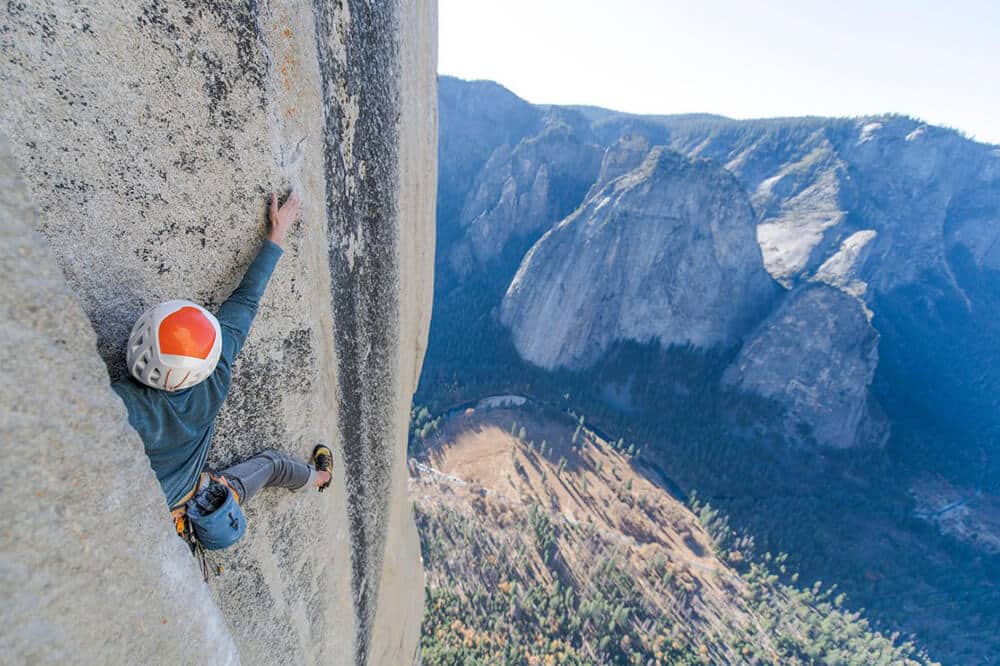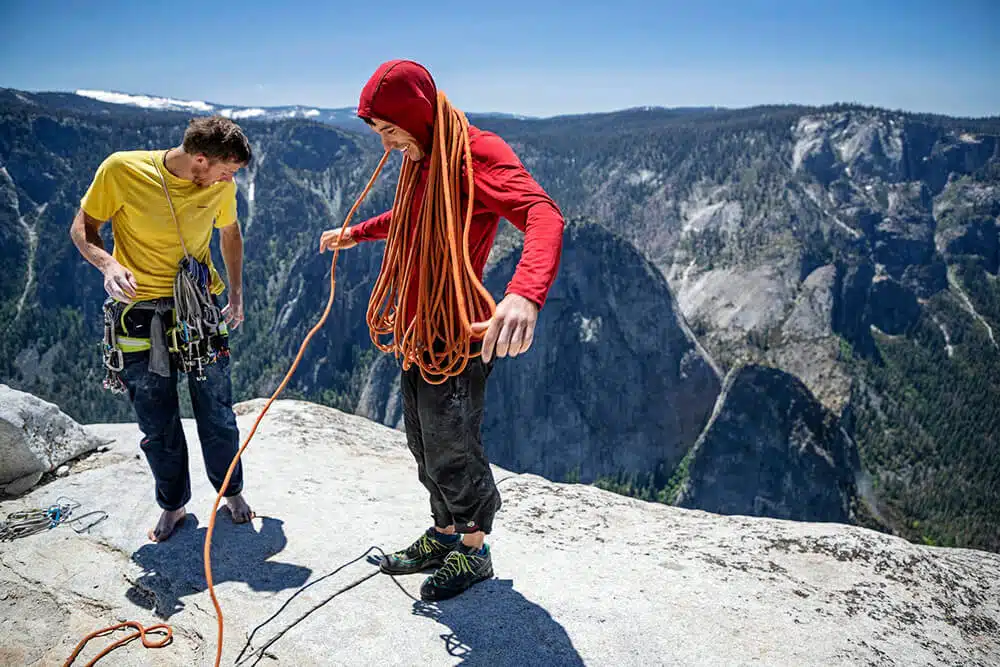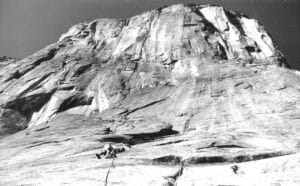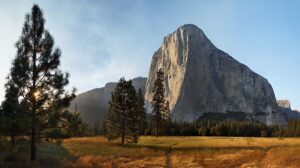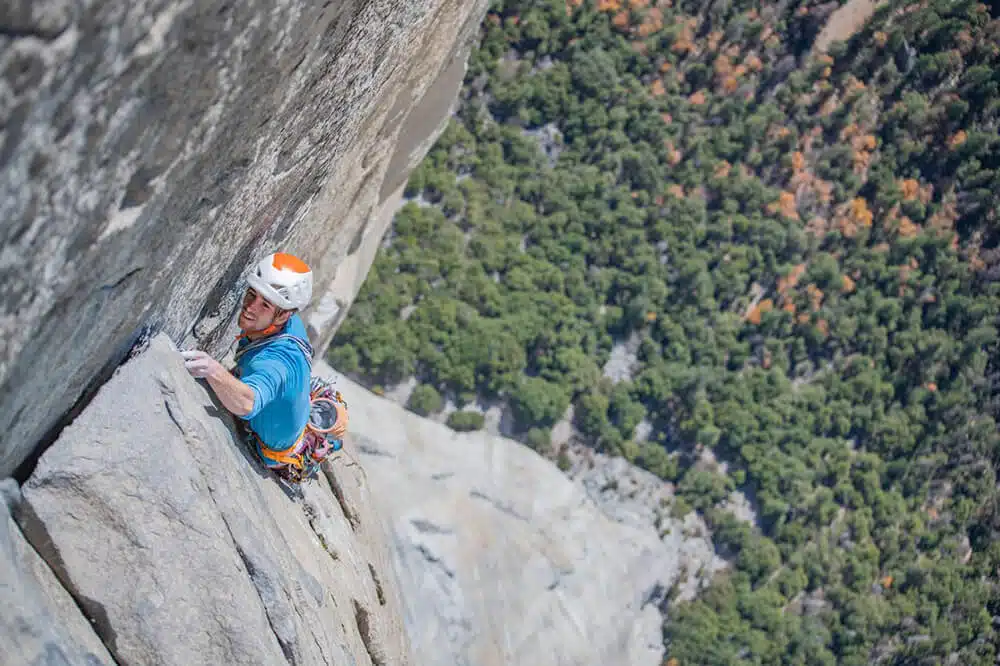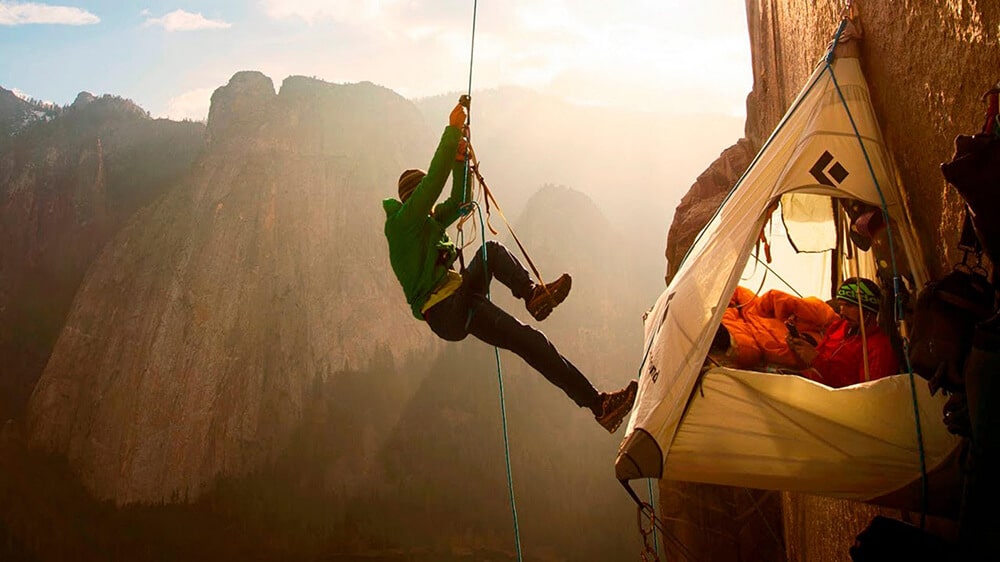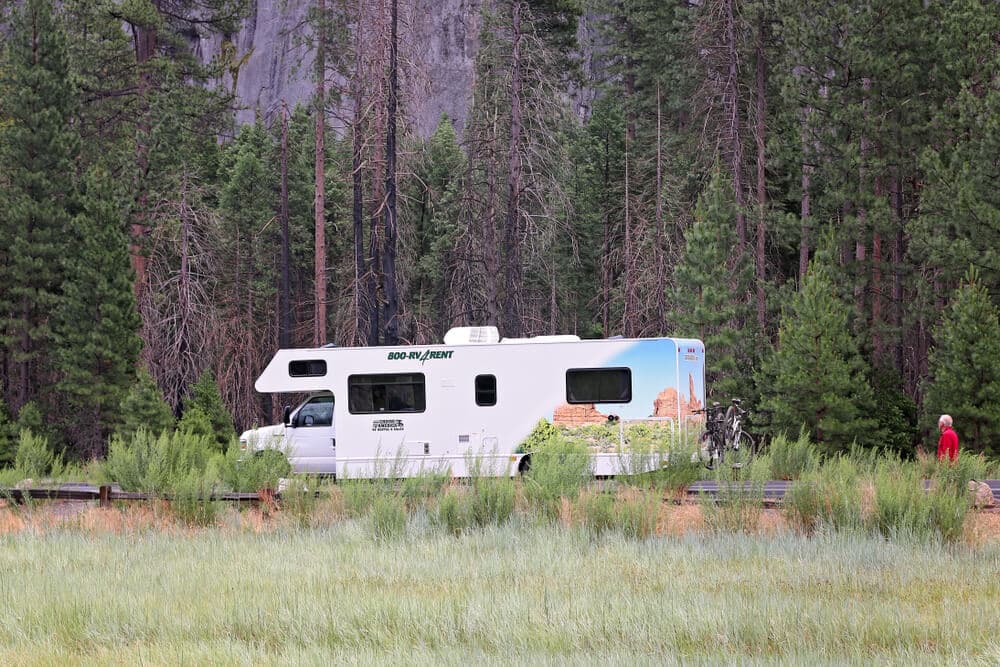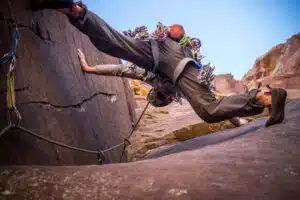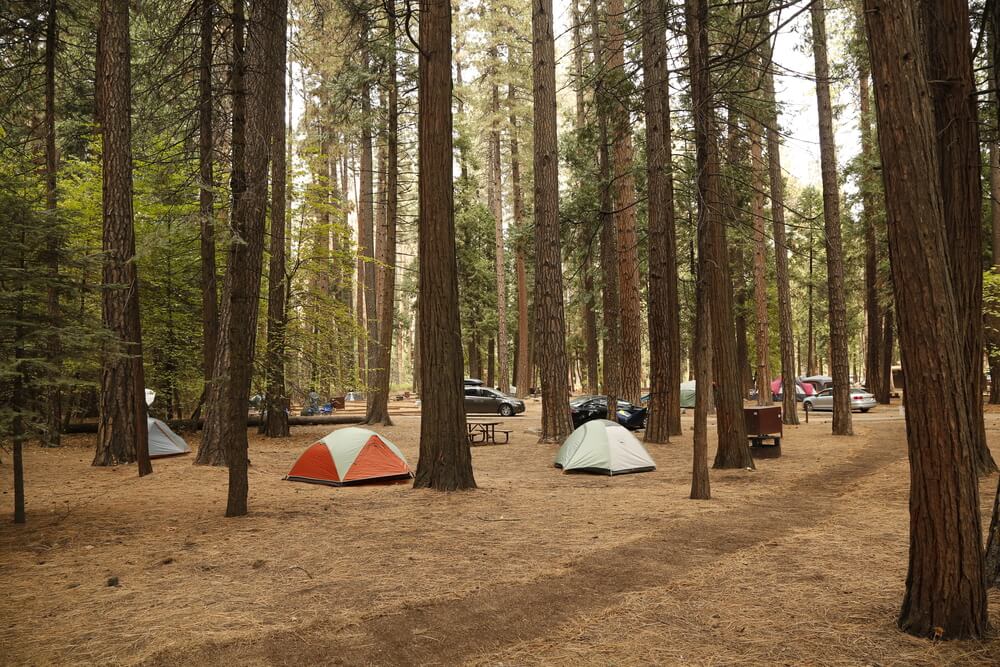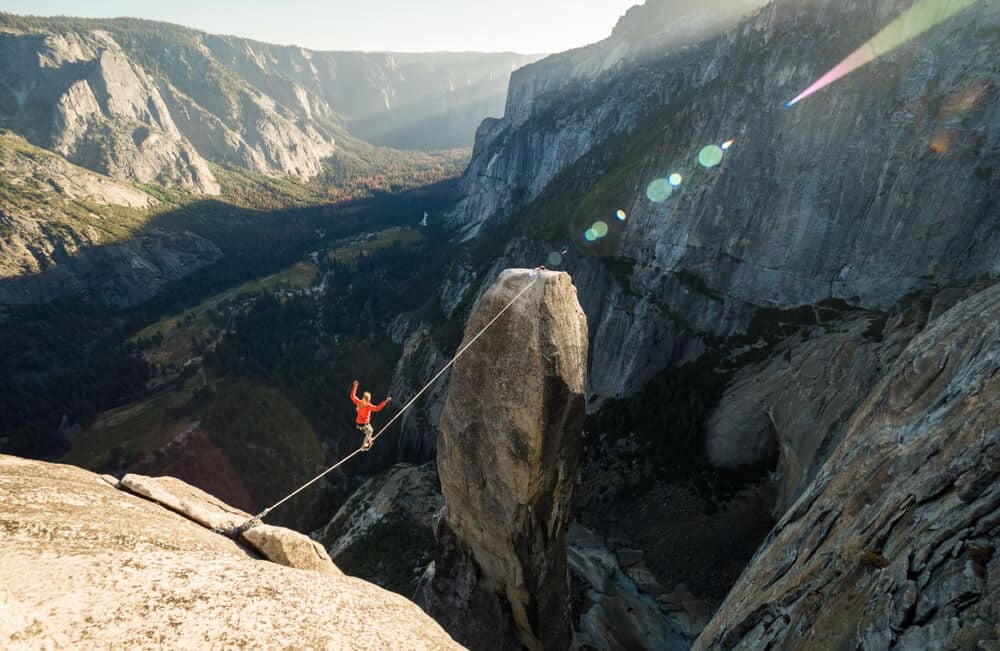Walk up to any passionate rock climber and start talking about “the Valley,” and they’ll know what you’re talking about despite the ambiguity.
That’s because the Valley, or Yosemite National Park, is one of the most internationally renowned rock climbing destinations in the world.
Every climber wants to go rock climbing in the Valley.
Every climber wants to sit in the Meadow and watch big-wallers climb El Capitan. Every climber wants to bathe in the Merced and eat an ice cream in the Village, and party in Camp 4. It’s in their climbing DNA.
Keep reading to learn about rock climbing in Yosemite. Below, I’ll dive into some history, talk about climbing and camping in the Valley, and share some pro tips to make your trip that much better.
Geologic History of Yosemite
The overall geology in Yosemite is dominated by granitic rock formations.
Roughly 10 million years ago, the Sierra Nevada mountains were uplifted and then tilted. These processes formed the gentle slopes found along the Western Sierra and the craggier, steep slopes of the Eastern Sierra, along with deep, narrow canyons.
Later, about 1 million years ago, glaciers formed at high elevations in the Sierra Nevadas. The glaciers moved down valleys like Yosemite. At one point, the ice thickness in Yosemite was thought to be 4,000 feet deep.
As the glaciers moved down the slope, they sculpted the u-shaped valley and Yosemite’s most iconic climbing features like El Capitan and Half Dome.
Indigenous History of Yosemite National Park
The Southern Sierra Miwuk Nation was the original population of people that called Yosemite and its surrounding areas home. The word Yosemite is Miwuk and translates to “those who are killers,” referring to the Awahneechee, a mixed tribe of people from Miwuk and Mono Paiute backgrounds who lived in and protected the Valley.
The Yosemite Valley provided invaluable natural resources that sustained their daily lives. In addition, the land served as a protective sanctuary, providing much-needed shelter from encroaching Spanish, Mexican, and North American colonists.
While the history of the Miwuk people has been difficult since the arrival of the colonists, many Southern Sierra Miwuk people still reside in Yosemite Mariposa County.
In addition, climbers visiting the Valley can still learn about the traditions of the Miwuk people at the Yosemite Museum. The museum features various exhibits displaying the cultural history of the Miwuk and Paiute people from 1850 to the present. Behind the museum is a demonstration of Indigenous buildings like a Chief’s house, ceremonial roundhouse, and sweat lodge.
Development of Yosemite Rock Climbing
Despite humans having populated the Yosemite Valley and surrounding areas like Tuolumne Meadows since the first people of the Miwuk and Paiute, climbing wasn’t really a thing until the 1950s.
The 1950s to the 70s is generally regarded as the Golden Age of Yosemite rock climbing.
During the Golden Age, everything was brand new, and daring first ascents were being put up all over the Valley. Climbers like Warren Harding and Royal Robbins supplanted Yosemite’s walls well into the foreground of American rock climbing.
From there, a generation of climbers known as the Stone Masters took over.
For about a decade, the Stone Masters were obsessed with free climbing the old aid lines of the previous generation. Incredible big wall ascents went down in single days, like Lynn Hills’ first female ascent of The Nose. Meanwhile, cutting-edge and mega-hard single-pitch routes like Ron Kauk’s Magic line and boulders like Midnight Lightening shattered what was previously understood as possible for rock climbers.
From there, the Stone Monkey generation came next.
More first-free ascents of classic lines, daring speed climbing, and even some free soloing began to take place on the Valley walls. This was when legends like the Huber Brothers, Tommy Caldwell, and Alex Honnold carved their names into the history books of Yosemite’s most impressive rock climbers.
Climbing in Yosemite Valley
Simply put, Yosemite National Park is one of planet Earth’s most impeccable rock climbing destinations.
The Valley is well known for impressive features like El Capitan, Half Dome, and Royal Arches. You can enjoy multi-pitch climbing on big walls like these, some of which may even take you multiple days. Or you can chase down shorter classic climbs that you can do in a day.
The vast majority of climbing in the Valley is traditional climbing. However, there are some areas within the National Park where you can also enjoy sport climbing. For example, Tuolumne Meadows in Yosemite’s high country is home to some of Sierra’s best sports climbs. In addition, crags down the valley in the Lower Merced River Canyon feature more sport routes.
Climbing on Yosemite Granite
Regarding granite rock climbing, Yosemite is more or less the barometer.
In other words, all other granite is compared to and often pales in comparison to the granite that Yosemite climbing is known for. Simply put, climbing in Yosemite is pure pleasure.
The granite rock formations scattered through the National Park, like Half Dome, El Capitan, the Leaning Tower, Washington Column, and the Royal Arches, have it all. But most notably, the granite in Yosemite is known for splitter cracks and flaring cracks. In addition, there are miles of thin slabs in Yosemite, where dime-edge holds are the only nearby features.
And, of course, like all the best granite in the world, pinching crystals is an integral part of the climbing on Yosemite granite.
Classic Starter Climbs in Yosemite Valley
Yosemite doesn’t only have big wall climbs for the likes of Emily Harrington and Jorg Verhoeven. There are plenty of rock climbs for mere mortals like you and me. So, if you want to prepare for something bigger or want a day out moving over impeccable stone, check out the following long free climbs, which most folks do in a day (or less).
But don’t be misunderstood. Even cutting your teeth on “starter” routes in Yosemite will feel adventurous and maybe sandbagged compared to what you are used to. In addition, the approaches can be tricky, long, and involved.
Wilderness Climbing Permits
A new policy has instituted the requirement of wilderness climbing permits for all overnight big wall climbs in the Valley.
The new permitting system was designed so that climbing rangers could better understand the climbing patterns on big wall climbs.
In addition, the new permit policy will hopefully enforce compliance with existing regulations and minimize impacts on behalf of rock climbers.
What to know about wilderness climbing permits
- Permits are available by self-registration
- Permits are free
- There are no limits on the amount of wilderness permits available
- When Eastern Yosemite Valley closes due to seasonal flooding, permits are available at the Arch Rock Entrance
The Best Time to Climb in Yosemite
Due to the Valley’s world-renowned climbing, climbers visit during all seasons of the year. However, it’s generally understood that the best conditions for rock climbing are during the Spring and Fall months of the year.
In the Spring, you will get mild temperatures during the day and cold (and potential for really cold) temperatures overnight. During Springtime, access to some climbing areas will be closed until June, depending on the snowpack from the previous winter.
In the Fall, the days are shorter, but the climate is drier, which is ideal for climbing. Temperatures are mild during the day and can be cold overnight. The fall is one of the most beautiful times in the Valley. By October, things will begin to freeze at higher elevations.
Climbing during the Summer months is possible; however, the weather is hot and can be unpredictable. For the most comfortable climbing, start early and seek out routes that will get some afternoon shade. Even better, you can avoid the Valley entirely in the summer and climb up in Tuolumne Meadows instead; you’ll get cooler temps and fewer crowds.
Getting to Yosemite National Park
The rock climbing in Yosemite is incredibly accessible. Travelers who fly to California can begin their journey in either San Francisco, Oakland, or Sacramento airports. From there, you’re only about a four-hour drive to the Valley.
By Plane/ Car
- San Francisco International Airport (SFO): 2.5 hours to the Big Flat entrance via highway CA 120, 3.5 hours to the heart of the Valley.
- Fresno International Airport (YAT): 1.25 hours to the Southern Entrance via highway CA 41, 2.5 hours to the heart of the Valley.
- Oakland (OAK): 2.75 hours to the Big Flat entrance via highway CA 120, 3.5 hours to the heart of the Valley.
- Sacramento (SMF): 2.24 hours to the Big Flat entrance via highway CA 120, 3.5 hours to the heart of the Valley
By Bus
- Yosemite Area Regional Transportation System (YARTS) provides a transportation service to Yosemite National Park
By Train
- Amtrak trains service major cities in California like San Diego, Los Angeles, Fresno, San Jose, Sacramento, and San Francisco. From any of those major hubs, you can transfer to the YARTS bus service.
Camping in Yosemite
There are thirteen campgrounds in Yosemite National Park. Reservations are required for all campgrounds from April through October. However, there are also three campgrounds you can use without reservation during certain parts of the year (Camp 4 is one of them).
Making a reservation for a campground in Yosemite can be difficult due to the popularity of the National Park. For that reason, it’s recommended that you plan your trip well in advance. For example, for some campgrounds in the Valley, like Upper and Lower Pines or Hodgdon Meadow, you can make a reservation up to five months in advance.
If not staying in Camp 4, the Upper or Lower Pines campgrounds tend to be the most popular amongst climbers, especially for those who like to sleep in their vehicles.
Guidebooks for Yosemite
There are many guidebooks for climbing in Yosemite. I recommend selecting the book that matches your preferred climbing style and climbing goals. I’ll mention a few of the most popular, but you may need to do some more of your own reading.
- Yosemite Free Climbs: 2020 Rock Climbing Yosemite Valley- 750 Best Free Routes
- Yosemite Big Walls: Yosemite Bigwalls- The Complete Guide
- Yosemite Bouldering: Yosemite Bouldering Guidebook
- Tuolumne Meadows: Tuolumne Meadows Climbing: A Comprehensive Guide (IDK WHY SURFER SAYS LINK IS BROKEN)
Hiring a Climbing Guide in Yosemite
If you want to go climbing in Yosemite but think you need a guide, there’s only one option, and fortunately, it’s a good one–Yosemite Mountaineering School (YMS).
YMS is the Valley’s premier guide service. YMS will be able to offer you a great introduction to the wonderful climbing in the Valley. They’ve been around since the 1960s and have guided tens of thousands of climbers up Yosemite’s cliffs. If you are into other types of outdoor adventures, like hiking and backpacking, YMS can help facilitate that, too.
Pro Tips for Better Enjoyment
Here’s what I’ve learned from personal experience and from chatting with other climbers.
Stay in Camp 4
There are many campgrounds in Yosemite National Park. However, none are as steeped in climbing history as Camp 4. Yes, a lot has changed in Camp 4 compared to the golden years. However, Camp 4 continues to be a favorite spot for many climbers.
Camping in Camp 4 is sought after for many reasons. Camp 4 is located in a beautiful spot on the valley floor. You’re walking distance from a ton of classic routes, not to mention the iconic Camp 4 boulders. In addition, the campground serves as a meeting ground for finding climbing partners and hanging out. Plus, it’s super affordable compared to other campgrounds in the Valley.
Swim in the Merced River
The Merced, which is the shortened version of the river’s full name – Rio de Nuestra Señora de la Merced (River of Our Lady of Mercy)– is an iconic feature in Yosemite. It snakes through the valley floor, creating an intricate and important riparian ecosystem for an array of flora and fauna. It also functions as an ideal place to cool off after climbing splitter cracks all day or as a beach during your rest day.
Bring a Bicycle
Unfortunately, the Valley has become somewhat notorious for its automobile traffic. For that reason, many people who visit Yosemite bring bicycles. You can get anywhere you need to in Yosemite on a bicycle. You’ll get a good workout, save a ton of time, and mitigate your impact on the environment.
Hangout in El Capitan Meadow (with binoculars)
For rock climbers, the El Cap meadow in Yosemite Valley is like a living room where big wall TV is streaming 24/7.
It’s the ideal spot to hang out and observe climbers as they cast off up their big wall climbs.
So, if you’ve got time to spare, and want to get psyched, go spend the morning in the meadow and get eyes on iconic routes like the Dawn Wall and Golden Gate.
Final Thoughts- Put Yosemite National Park on Your Bucket List
This is going to sound cliche, but when it comes to rock climbing, there is no other place on Earth like Yosemite. There’s a reason why humans have occupied the Valley since the first peoples of the Miwuk and Paiute Nations and why it’s been protected as a National Park since October 1890– it’s extraordinary. And it belongs on your bucket list of climbing destinations.
So, head to the gym and start training, practice your knots, master different anchor systems, and bone up on self-rescue techniques. Yosemite is waiting!


